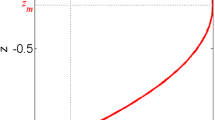Abstract
A three-dimensional tidal current model is developed and applied to the East China Sea (ECS), the Yellow Sea and the Bohai Sea. The model well reproduces the major four tides, namely M2, S2, K1 and O1 tides, and their currents. The horizontal distributions of the major four tidal currents are the same as those calculated by the horizontal two-dimensional models. With its high resolutions in the horizontal (12.5 km) and the vertical (20 layers), the model is used to investigate the vertical distributions of tidal current. Four vertical eddy viscosity models are used in the numerical experiments. As the tidal current becomes strong, its vertical shear becomes large and its vertical profile becomes sensitive to the vertical eddy viscosity. As a conclusion, the HU (a) model (Davieset al., 1997), which relates the vertical eddy viscosity to the water depth and depth mean velocity, gives the closest results to the observed data. The reproduction of the amphidromic point of M2 tide in Liaodong Bay is discussed and it is concluded that it depends on the bottom friction stress. The model reproduces a unique vertical profile of tidal current in the Yellow Sea, which is also found in the observed data. The reason for the reproduction of such a unique profile in the model is investigated.
Similar content being viewed by others
References
An, H. S. (1977): A numerical experiment of the M2 tide in the Yellow Sea.J. Oceanogr. Soc. Japan,33, 103–110.
Choi, B. H. (1980): A tidal model of the Yellow Sea and the eastern China Sea. KORDI Report 80-02, 72 pp.
Choi, B. H. (1984): A three-dimensional model of the East China Sea. p. 209–224. InOcean Hydrodynamics of the Japan and East China Seas, ed. by T. Ichiye, Elsevier, Amsterdam.
Choi, B. H. (1985): Observed and computed tidal currents in the East China Sea.J. Oceanogr. Soc. Korea,20, 56–73.
Choi, B. H. (1989): A fine-grid three-dimensional M2 tidal model of the East China Sea. p. 167–185. InModeling Marine Systems, ed. by A. M. Davies.
Davies, A. M., S. C. M. Kwong and R. A. Flather (1997): Formulation of a variable-function three-dimensional model, with application to the M2 and M4 tide on the North-West European Continental Shelf.Cont. Shelf Res.,17, 165–204.
Ding, W. (1984): A study on the characteristics of the tide and tidal current in the East China Sea.Studia Marinea Sinica,21, 135–148 (in Chinese).
Fang, G. (1986): Tide and tidal current charts for the marginal seas adjacent to China.C. J. of Oceanology and Limnology,4, 1–16.
Fang, G. and T. Ichiye (1983): On the vertical structure of tidal currents in a homogeneous sea.Geophys. J. R. Astr. Soc.,73, 65–82.
Guo X. and T. Yanagi (1994): Three dimensional structure of tidal currents in Tokyo Bay, Japan.La mer,32, 173–185.
Larsen, L. H., G. A. Cannon and B. H. Choi (1985): East China Sea tide currents.Cont. Shelf Res.,4, 77–103.
Nishida, H. (1980): Improved tidal charts for the western part of the north Pacific Ocean.Report of Hydrographic Researches,15, 55–70.
Ogura, S. (1933): The tides in the sea adjacent to Japan.Bulletin of the Hydrographic Department, Imperial Japanese Navy,7, 1–189.
Shen, Y. (1980): Numerical computation of tides in the East China Sea.Journal of Shandong College of Oceanology,10, 26–35 (in Chinese with English abstract).
Xing, J. and A. M. Davies (1996): Application of turbulence energy models to the computation of tidal currents and mixing intensities in shelf edge regions.J. Phys. Oceanogr.,26, 417–447.
Yanagi, T. and K. Inoue (1994): Tide and tidal current in the Yellow/East China Seas.La mer,32, 153–165.
Yanagi, T., A. Morimoto and K. Ichikawa (1997): Co-tidal and corange charts for the East China Sea and the Yellow Sea derived from satellite altimetric data.J. Oceanogr.,53, 303–310.
Ye, A. and L. Mei (1995): Numerical modeling of tidal waves in the Bohai Sea, the Huanghai Sea and the East China Sea.Oceanologia et Limnologia Sinica,26, 63–70 (in Chinese with English abstract).
Zhao, B., G. Fang and D. Chao (1994): Numerical simulations of the tide and tidal current in the Bohai Sea, the Yellow Sea and the East China Sea.Acta Oceanologica Sinica,16, 1–10 (in Chinese).
Author information
Authors and Affiliations
Rights and permissions
About this article
Cite this article
Guo, X., Yanagi, T. Three-dimensional structure of tidal current in the East China Sea and the Yellow Sea. J Oceanogr 54, 651–668 (1998). https://doi.org/10.1007/BF02823285
Received:
Revised:
Accepted:
Published:
Issue Date:
DOI: https://doi.org/10.1007/BF02823285




